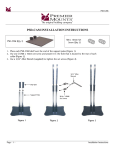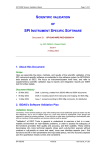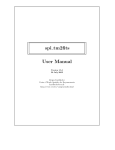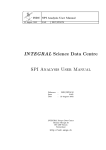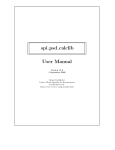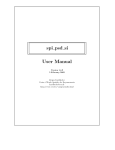Download spi psd respgen User Manual
Transcript
spi psd respgen User Manual Version 2.0.1 22 January 2003 Jurgen Knodlseder Centre d'Etude Spatiale des Rayonnements [email protected] http://www.cesr.fr./jurgen/index.html spi psd respgen User Manual Note to the user This software has been written to analyse data of the SPI telescope onboard INTEGRAL. Particular care has been taken in making the software user friendly and well documented. If you appreciated this eort, and if this software and User Manual were useful for your scientic work, the author would appreciate a corresponding acknowledgment in your published work. ii spi psd respgen User Manual iii Contents 1 Introduction 1 2 Getting started 1 3 Parameter le 2 4 Interface denition 4 5 Algorithm 4 6 Error codes 5 spi psd respgen User Manual 1 1 Introduction The executable spi psd respgen is part of the SPI scientic analysis preparation software component (SAP). It generates the SPI PSD response function for a given observation group by interpolating PSD response factors that are stored in a SPI.-DISC-PSD data structure. Consequently, spi psd respgen has to be executed after spi psd optimise but before the imaging or spectral analysis steps. If the response factors PSD FB should be taken into account for background modelling, spi psd respgen should be executed before spiback or spi obs back. spi psd respgen adds a data structure of HDU type SPI.-OBS.-PRF to the observation group. spi psd respgen is written in the ANSI C++ language and has been developped under ISDC support platform 5.1. It requires spi toolslib version 2.0.0 and spi psdlib version 2.0.0 or higher. 2 Getting started Before installing spi psd respgen, make sure that the ISDC support platform 5.1 or higher is installed on your system, and that you have installed the library spi toolslib version 2.0.0 and spi psdlib version 2.0.0 or higher. After downloading the spi psd respgen.tar.gz le, step into a directory that should hold the distribution, move the spi psd respgen.tar.gz le into this directory and type after the UNIX prompt $ (don't type this prompt): $ gunzip spi_psd_respgen.tar.gz $ tar xvf spi_psd_respgen.tar The rst command uncompresses the distribution le, the second unpacks the les. Before conguration, the distribution needs to be reset to a clean state. To do this, type $ make distclean Then, congure the distribution. It is assumed here that you have previously installed the ISDC support platform, thus you should type $ ~/bin/ac_stuff/configure Finally, build the distribution by typing $ make global_install To perform a unit test, type $ make test Make sure that the test data spi test data-1.0.tar.gz are available at your site (they should reside in a directory whose name is dened by the ISDC TEST DATA DIR environment variable). spi psd respgen User Manual 2 3 Parameter le ####################################################################### # # # Centre d'Etude Spatiale des Rayonnements # # (in collaboration with ISDC) # # # # SPI PSD response generation # # # # ------------------------------------------------------------------- # # # # File: spi_psd_respgen.par # # Version: 2.0.1 # # Component: SAP # # # # Author: Juergen Knoedlseder # # [email protected] # # CESR # # # # Purpose: Parameter file of the SPI PSD response generation task # # # # History: 2.0.1 22-Jan-2003 Second ISDC delivery # # # ####################################################################### # # The input DOLs/filenames #========================= ingrpDOL,s,ql, "og_spi.fits[GROUPING]",,, "Input Observation Group DOL or filename" inebdDOL,s,ql, "boundaries.fits[SPI.-EBDS-SET]",,, "Energy boundary definition DOL or filename" ingtiDOL,s,ql, "gti.fits[SPI.-OBS.-GTI]",,, "Good Time Interval DOL or filename" indisDOL,s,ql, "psd_disc.fits[SPI.-DISC-PSD]",,, "PSD discrimination DOL or filename" # # The output DOLs/filenames #========================== outgrpDOL,s,ql, "og_spi_psd.fits[GROUPING]",,, "Output Observation Group DOL or filename" outprfDOL,s,ql, "psd_response.fits[SPI.-OBS.-PRF]",,, "PSD response DOL or filename" # # Standard parameters #==================== clobber,b,h, yes,,, "Overwrite existing output data ?" verbose,i,h, 2,0,3, "Information logging level" Instead of specifying complete DOLs (Data Object Locations), which are composed of a lename plus the data structure extension (HDU), spi psd respgen accepts also simple lenames and adds the appropriate data structure extensions. This means that specied data structure extensions are ignored. The parameters have the following meaning: (optional) species the DOL or lename of the input Observation Group of HDU type for which the SPI PSD response function should be derived. The specication of this parameter is optional if an output Observation Group has been specied (parameter outgrpDOL). If left blank, the output group will be used as input group. This option may be used if one wants to add-on to an existing Observation Group (in this case the clobber parameter has to be set to yes). ingrpDOL [GROUPING] spi psd respgen User Manual 3 For safety, however, it is recommended to create a new output Observation Group (which will take only little space on your disk). Only an Observation Group is accepted for this parameter, other data or group types (such as science window groups or index groups) will be rejected. inebdDOL (optional) species the DOL or lename of an energy boundary denition le of HDU type [SPI.-EBDS-SET]. If a [SPI.-EBDS-SET] element exists already in the input Observation Group, this element will be replaced by the specied DOL in the output Observation Group. If no [SPI.-EBDS-SET] element exists in the input Observation Group, the specied DOL will be attached to the output Observation Group. Leaving this parameter blank will lead spi psd respgen to search for this element in the input Observation Group. This is the recommended default method. Note that spi psd respgen only works for calibrated energies, hence the energy boundary denition must be specied for calibrated energies (CHANTYPE=PI). (optional) species the DOL or lename of a Good Time Interval list of HDU type . If a [SPI.-OBS.-GTI] element exists already in the input Observation Group, this element will be replaced by the specied DOL in the output Observation Group. If no [SPI.-OBS.-GTI] element exists in the input Observation Group, the specied DOL will be attached to the output Observation Group. Leaving this parameter blank will lead spi psd respgen to search for this element in the input Observation Group. This is the recommended default method. indisDOL (optional) species the DOL or lename of a PSD discrimination and response parameter le of HDU type [SPI.-DISC-PSD]. If a [SPI.-DISC-PSD] element exists already in the input Observation Group, this element will be replaced by the specied DOL in the output Observation Group. If no [SPI.-DISC-PSD] element exists in the input Observation Group, the specied DOL will be attached to the output Observation Group. Leaving this parameter blank will lead spi psd respgen to search for this element in the input Observation Group. This is the recommended default method. outgrpDOL (optional) species the DOL or lename of the output Observation Group of HDU type [GROUPING]. The output Observation Group will be a copy of the input Observation Group plus the resulting SPI PSD response function data structure [SPI.-OBS.-PRF] attached. The specication of this parameter is optional if an input Observation Group has been specied (parameter ingrpDOL). If left blank, the input group will be used as output group. This option may be used if one wants to add-on to an existing Observation Group (in this case the clobber parameter has to be set to yes). For safety, however, it is recommended to create a new output Observation Group (which will take only little space on your disk). Only an Observation Group is accepted for this parameter, other data or group types (such as science window groups or index groups) will be rejected. outprfDOL species the DOL or lename of the SPI PSD response function of HDU type [SPI.-OBS.-PRF]. This le will be attached to the output Observation Group. Any existing DOL of the same type that may already exist in the output Observation Group will be detached before. If the specied DOL is identical to an already existing DOL, this DOL will be deleted if the clobber parameter is yes (otherwise an error will occur). clobber species if existing output data structures should be overwritten or not. If yes is specied, the executable will notify the user about the deletion of any le. If no is specied and the executable attempts to overwrite existing data (e.g. an existing output Observation Group or PSD response structure), the task will exit with an error message. verbose species the verbose level of the executable. For verbose=0, no information will be logged in case of an error. For verbose=1, only errors will be logged, while for verbose=2 also actions (such as DOL detachments and attachments and DOL deletion) will be logged. verbose=3 provides a detailed report about the SPI PSD response function generation. ingtiDOL [SPI.-OBS.-GTI] spi psd respgen User Manual 4 4 Interface denition takes the information that is available in the PSD discrimination and response parameter data structure (HDU extension SPI.-DISC-PSD) and derives from it the PSD response function for a given Observation Group. In addition to this HDU, it also requires a SPI.-EBDS-SET and a SPI.-OBS.-GTI HDU to determine the energy boundary denition of the event spectra, and the Good Time Intervals and pointings that are present in the Observation Group. spi psd respgen stores the calculated SPI PSD response function in a data structure of HDU type SPI.-OBS.-PRF where it creates two columns PSD FP and PSD FB with the same number of column bins than the event spectra have (i.e. the column size is set by the executable). For each pointing, SPI.-OBS.-PRF contains 19 rows, one for each SPI detector (with detector identiers in the order 0 - 18). From the input Observation Group, the following HDUs are required: spi psd respgen SPI.-EBDS-SET SPI.-OBS.-GTI SPI.-DISC-PSD Energy boundary denition of the observation Good Time Intervals PSD discrimination parameters and response factors All members of the input Observation Group become members of the output Observation Group. In addition, the following additional HDU is attached to the output Observation Group (or replaced if it exists already): SPI.-OBS.-PRF PSD response function If no output Observation Group is specied, spi psd respgen attempts to make the input Observation Group to the output Observation Group, which is only possible if the clobber parameter is set to yes. Vice versa, if no input Observation Group is specied, spi psd respgen uses the output Observation Group as input Observation Group. For more details on the group logic, the user is referred to the discription of the group API in the spi toolslib User Manual. 5 Algorithm The SPI PSD response function consists of the two parameters PSD FP and PSD FB. PSD FP is the probability that the PSD correctly recognises a photon event as a photon event (i.e. the probability that a photon event that was analysed by the PSD sub-assembly got a PSD FLAG=1). It is emphasised that only the fraction of analysed events are taken into account, hence events that had an analysis error are not considered (the fraction of events that either escaped the SPI PSD sub-assembly due to deadtime, or that were assigned an analysis error is stored in the column PSD EFF of the data structure SPI.-OBS.-PEF). PSD FP is in general detector, energy and time dependent. For a given set of energies and time intervals, the executable spi psd optimise determines the PSD FP factors by analysing the SPI PSD discrimination of instrumental background photons for each detector. spi psd optimise may devide an Observation Group in time intervals of constant ONTIME, and therefore may derive time dependent PSD FP factors. These factors are stored together with the PSD discrimination parameters in a SPI.-DISC-PSD data structure. spi psd respgen takes these factors and performs a linear interpolation in energy to obtain PSD FP for each energy bin of the Observation Group and each detector. In order to handle a time dependent PSD response, it determines for each pointing the set of PSD FP from the SPI.-DISC-PSD data structure that has the longest time overlap with the pointing time interval. The pointing time interval is dened by the spi psd respgen User Manual 5 earliest and latest time for a given detector and pointing. If for any reason no valid pointing time interval could be determined, the rst set of PSD FP factors that is found in SPI.-DISC-PSD is used. PSD FB is the probability that the PSD correctly recognises a background event as a background event (i.e. the probability that a background event that was analysed by the PSD sub-assembly got a PSD FLAG=0). Also these factors are determined by spi psd optimise, and interpolated and assigned in the same manner by spi psd respgen as it is the case for PSD FP. Note that PSD FB are not directly required by imaging or spectral analysis, yet they may be useful for background modelling. 6 Error codes The executable spi psd respgen may stop with the following error codes: SPI_PSD_RESPGEN_ERROR_MEM_ALLOC SPI_PSD_RESPGEN_ERROR_OVERWRITE SPI_PSD_RESPGEN_ERROR_NOT_PI -231900 -231901 -231902 They have the following meaning: : the allocation of dynamical memory has failed. Probable your system resources are too limited to run this task. SPI PSD RESPGEN ERROR OVERWRITE : the task attempted to overwrite a data structure while the clobber parameter was set to no. SPI PSD RESPGEN ERROR NOT PI : the SPI.-EBDS-SET data structure is not dened for calibrated energies. Yet, spi psd respgen only can handle calibrated energies since they are needed for response interpolation. SPI PSD RESPGEN ERROR MEM ALLOC In addition, all errors that may occur in calls to ISDC support functions (such as for example DAL, RIL or PIL) are forwarded. Please consult the ISDC web pages for getting information about these error codes.








